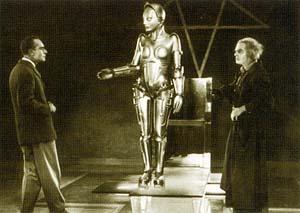
| D, 1925/26 Regie: Fritz Lang Drehbuch: Thea von Harbou Kamera: Karl Freund, Günther Rittau, Ausstattung: Otto Hunte, Erich Kettelhut, Karl Vollbrecht Produzent: Universum-Film AG Darsteller: Alfred Abel Gustav Fröhlich Rudolf Klein-Rogge Fritz Rasp Theodor Loos Erwin Biswanger Heinrich George Brigitte Helm Länge: 147’ Format: Normalbild, Schwarzweiß | |
METROPOLIS ist das prototypische offene Kunstwerk der Filmgeschichte: editorisch für immer unabschließbar, hermeneutisch unendlich ergiebig, ideologisch ausgesprochen anfechtbar. Thomas Elsaessers Zwischenbilanz: „Vielleicht übersteht Langs Film die widersprüchlichen Behandlungen, denen er über die Jahrzehnte ausgesetzt war, so gut, weil er die robuste Gestalt eines Märchens hat. Solche Geschichten überstehen raue Behandlungen unversehrt, dank ihrer Redundanzen und archetypischen Konfigurationen. Die Ufa konkurrierte nicht nur in Größe und Spezialeffekten mit dem US-Film, sondern wollte auch eine Romanze für das Zeitalter der Maschinen präsentieren - eine epische Geschichte, wie sie zuvor nur die Amerikaner zu erzählen wußten. Auch wenn METROPOLIS die Hoffnungen der Ufa nicht erfüllte, reproduzierte der Film doch sehr akkurat die doppelte Plot-Struktur der klassischen Hollywood-Narration, in der Märchen und Romanze mit einer Abenteuerhandlung und einer Suche verwoben werden. (...) Neben der Romanze zwischen Freder und Maria gibt es das romantisch-gotische Märchen des Zauberlehrlings: Ein Erfinder erschafft ein künstliches menschliches Wesen, das Zerstörung über alle Beteiligten bringt. Dagegengestellt ist die Intrige um den ,Schmalen' - Auge und Ohr des Herrschers über Metropolis - und der schließlich vereitelte Plan, die Helfer des Helden zu neutralisieren. Die zweite Intrige ist Rotwangs Rache, der versucht, den Sohn des Mannes zu zerstören, der ihm seine Liebe raubte. (...) Neben den Elementen aus Volkserzählungen war weder der Symbolismus von der Jungfrau Maria noch die Aufteilung in Jungfrau und Hure vorherigen Kommentatoren entgangen, doch in der zynischen Berliner Atmosphäre von 1927 wurde die Figur der Maria mit unverhüllter Häme begrüßt. (...) In seinem einflußreichen Essay The Vamp and the Machine nimmt Andreas Huyssen zwei traditionelle Motive der Weimarer Republik auf: den ängstlichen Mann und den technophoben Kulturpessimismus der Intellektuellen. Seine Hauptthese lautet, dass dem Film eine sinnreiche und originelle Lösung dieser beiden Komplexe gelingt, indem eine Geschichte konstruiert wird, in der die kulturell verhältnismäßig junge Furcht vor ,unkontrollierbarer Technologie' auf die archaischere Furcht vor ,unkontrollierbarer weiblicher Sexualität' projiziert wird. Der Stil korrespondiert mit dieser Bewegung auf der ideologischen Ebene: Das expressionistische Pathos in der Sprache der Figuren wird schließlich von der kühlen Maschinenästhetik der Neuen Sachlichkeit begrenzt." (Thomas Elsaesser, Metropolis, 77-81, gekürzt) Musikbegleitung: Gerhard Gruber
The film is set in the year 2026, in the extraordinary Gothic skycrapers of a corporate city-state, the Metropolis of the title. Society has been divided into two rigid groups: one of planners or thinkers, who live high above the earth in luxury, and another of workers who live underground toiling to sustain the lives of the privileged. The city is run by Johhan 'John' Fredersen (Alfred Abel).
The beautiful and evangelical figure Maria (Brigitte Helm) takes up the cause of the workers. She advises the desperate workers not to start a revolution, and instead wait for the arrival of "The Mediator", who, she says, will unite the two halves of society. The son of Fredersen, Freder (Gustav Fröhlich), becomes infatuated with Maria, and follows her down into the working underworld. In the underworld, he experiences firsthand the toiling lifestyle of the workers, and observes the casual attitude of their employers (he is disgusted after seeing an explosion at the "M-Machine", when the employers bring in new workers to keep the machine running before taking care of the men wounded or killed in the accident). Shocked at the workers' living conditions, he joins her cause. Meanwhile his father Fredersen learns of the existence of the robotic gynoid built by the scientist Rotwang (Rudolf Klein-Rogge) and orders Rotwang to give the robot Maria's appearance. (Rotwang had wanted to give the robot the appearance of Fredersen's dead wife, Hel; both men had been in love with her, but in the end she had married Fredersen). By doing so he wants to spread disorder among the workers that would give him the pretext to carry out a retaliatory strike against them.
The real Maria is imprisoned in Rotwang's house in Metropolis, while the robot Maria becomes an exotic dancer in the city's Yoshiwara nightclub, fomenting discord among the rich young men of Metropolis. The workers are encouraged by the robot Maria into a full-scale rebellion, and destroy the "Heart Machine", the power station of the city. However, the destruction of the machine leads to the city's reservoirs overfilling, which floods the workers' underground city and seemingly drowns their children, who were left behind in the riot. (The children are in fact saved in a heroic rescue by Freder and Maria, without the workers' knowledge.) When the workers realize this, they attack out into the gridlocked and confused upper city, foreshadowing the "destruction of the enemy in the citadel" ending still seen in films. The crowd breaks into the city's entertainment district and captures the robot Maria, whom they believe is responsible for drowning their children. They burn the robot at the stake, and when Freder sees this, he believes that it is the real Maria and despairs. However, Freder and the workers then realise that "Maria" is in fact a robot, and see the real Maria being chased by Rotwang along the battlements of the city's cathedral. Freder chases after Rotwang, resulting in a climactic scene in which John Fredersen watches in terror as his son struggles with Rotwang on the cathedral's roof. Rotwang falls to his death, and Maria and Freder return to the street, where Freder unites John and Grot, the workers' leader, fulfilling his role as the "Mediator".
| |
http://filmmusik.at/ http://filmmusik.at/English/Gerhard-Gruber-Silentfilm-English.html http://filmmusik.at/Stummfilmpianist/Gerhard-Gruber-Stummfilmpianist.html
